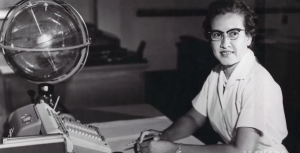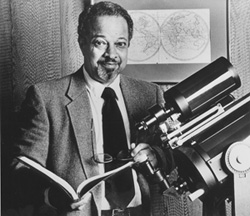Press Release from the Astronomy Society of the Pacific, one of our CosmoQuest partners:

Katherine Johnson sits at her desk with a globe, or “Celestial Training Device.”
Credits: NASA
San Francisco, California – August 15, 2016 – Dr. Katherine Johnson, NASA mathematician who calculated and verified the trajectories that took the first Americans into space and to the Moon, will be the inaugural recipient of the Astronomical Society of the Pacific’s Arthur B.C. Walker II Award. The Arthur B.C. Walker II Award recognizes outstanding achievement by an African American in astronomy and for actively promoting diversity in science. Dr. Johnson’ family will accept the award on her behalf on October 22, 2017 during the ASP’s Annual Award Gala in Burlingame, California. Dr. Katherine Johnson received the Presidential Medal of Freedom from President Barack Obama in 2015.

Former NASA mathematician Katherine Johnson is seen after President Barack Obama presented her with the Presidential Medal of Freedom, Tuesday, Nov. 24, 2015, during a ceremony in the East Room of the White House in Washington. Credit: NASA/Bill Ingalls
About Dr. Katherine Johnson
Katherine Coleman Goble Johnson (born August 26, 1918) is a space scientist and mathematician who made major contributions to aeronautics for NASA’s space programs from 1953 to 1986. Known for the accuracy of her orbital calculations, she determined the trajectory for Project Mercury and the 1969 Apollo 11 flight to the Moon. When NASA used electronic computers for the first time to calculate John Glenn’s orbit around Earth, Glenn insisted that she verify the computer’s numbers. NASA dedicated the Katherine G. Johnson Computational Research Facility at the Langley Research Center in Hampton, Virginia on May 5, 2016. This occurred on the 55th anniversary of Alan Shepard’s historic rocket launch and splash down, which Katherine Johnson helped make possible through her orbital calculations. After retiring from NASA, Dr. Johnson dedicated herself to inspiring young people to pursue careers in science, mathematics, and engineering.

Arthur Bertram Cuthbert Walker II, professor of physics and applied physics. Credit: Victoria Walker.
About Dr. Arthur B.C. Walker II
Arthur B.C. Walker II (1936 – 2001), Professor of Physics and Applied Physics at Stanford University, was a renowned and highly respected aerospace engineer and solar physicist. While at Stanford, Arthur was an active member of the Center for Space Science and Astrophysics and chaired the Astronomy Program from 1977 until 1980. His most significant contribution to academic life at Stanford was mentoring under-represented graduate students in science, namely women and African-Americans. Among these students was Sally Ride, the first female U.S. astronaut. He was also a leader of the African American community at Stanford and the longest serving member of the advisory committee for the Afro-American studies program. He served as a role model for many of the young African-American assistant professors including Condoleeza Rice.
NASA recognized his lifetime of service during a combined meeting of the National Conference for Black Students and the National Society of Black Physicists in 2001. Dr. Walker’s devotion to science and service encouraged and promoted African Americans to enter physics as a profession at all levels.
About the Arthur B.C. Walker II Award
The ASP’s Arthur B.C. Walker II Award has been established to honor an outstanding scientist whose research and educational efforts substantially contributes to astronomy and who has (1) demonstrated a substantial commitment to mentoring students from underrepresented groups pursuing degrees in astronomy and/or (2) been instrumental in creating or supporting innovative and successful STEM programs designed to support underrepresented students or their teachers.
The Arthur B.C. Walker II Award also includes an “Arthur B.C. Walker II Scholarship” which the recipient gives to a student of their choice. In addition, and perhaps even more important than the financial benefit, the prestigious scholarship from the ASP will help support the student’s academic and career goals.

About The Astronomical Society of the Pacific (ASP)
The ASP is a 501c3 nonprofit organization whose mission is to use astronomy to increase the understanding and appreciation of science and to advance science and science literacy. The ASP connects scientists, educators, amateur astronomers and the public together to learn about astronomical research, improve astronomy education, and share resources that engage learners of all kinds in the excitement and adventure of scientific discovery. Current ASP programs and initiatives support college faculty, K-12 science teachers, amateur astronomy clubs, science museums, libraries, park rangers, and girl scouts to name a few.
Through its annual awards, ASP recognizes achievement in research, technology, education, and public outreach. The awards include the ASP’s highest honor, the Catherine Wolfe Bruce Gold Medal awarded since 1898 for a lifetime of outstanding research in astronomy. The Bruce Medal has gone to some of the greatest astronomers of the past century, including Arthur Eddington, Edwin P. Hubble, Subramanyan Chandrasekhar, and Vera Rubin. The ASP also presents the Klumpke-Roberts Award for outstanding contributions to the public understanding and appreciation of astronomy. Past awardees include Carl Sagan, Isaac Asimov, and the Hubble Heritage Project.
There will also be a movie soon, titled “Hidden Figures,” that details the story of Dr. Johnson and the other African-American women behind the scenes during the Space Race. Stay tuned for our next blog post to read more about this movie!




 Join the Crew!
Join the Crew!
 Escape Velocity Space News
Escape Velocity Space News
0 Comments
Trackbacks/Pingbacks